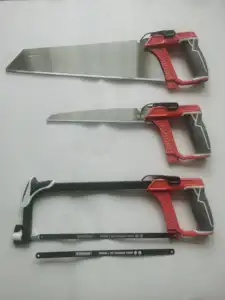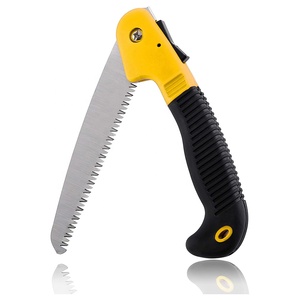
Popular Factory Directly Wholesale Orchard 210mm Folding Saw Japanese Saw Wood Cutting Panel Hand Saw Garden Hand Saw





















A woodworking hand saw is an indispensable instrument for carpenters and woodworkers, crafted for the precise and effortless cutting of wood. This term covers a spectrum of manually operated saws, each specialized for distinct roles in the woodworking sector. Such saws are crucial for meticulous tasks where electric tools are unsuitable or when greater manual control is desired for refined precision.
An extensive selection of types of woodworking saws exists, each with its own set of features tailored to various woodworking operations. The Japanese woodworking saw, or nokogiri, is celebrated for its slender blade and delicate teeth, making it perfect for exacting joinery work. In contrast, traditional Western saws employ a push-stroke technique, providing sturdiness for routine cutting jobs. Specialty saws, such as dovetail saws with their fine teeth and linear handles, are engineered for intricate dovetail cuts in joinery. The small wood saw excels in crafting detailed shapes and curves, commonly utilized in model making and craftwork. Meanwhile, the electric wood hand saw offers a motorized option for uniform and less strenuous cuts, apt for repetitive tasks in industrial settings.
The architecture of a woodworking saw is thoughtfully conceived to strike a balance between resilience and cutting prowess. An ergonomically designed handle is affixed to a serrated blade. The teeth's design varies, with crosscut saws featuring teeth angled to slice through wood grains, while rip saws have chisel-like teeth for cutting with the grain. Certain saws are reinforced at the back to guarantee straight cuts, a critical aspect for joinery accuracy. Blade tension is equally vital, influencing the saw's straight-cutting capability and resistance to warping.
The materials chosen for woodworking hand saws prioritize strength, longevity, and cutting proficiency. Manganese steel is a favored material for blades, owing to its durable nature and edge retention. Aluminum alloy handles offer a firm yet lightweight hold, mitigating user fatigue. The use of SK5 high-carbon steel in some blades provides an optimal mix of durability and sharpness retention, crucial for neat cuts and sustained usage.
In the commercial sphere, woodworking hand saws are adaptable instruments employed across diverse sectors. In the furniture-making industry, precision is of the essence, and hand saws are often the tools of choice for their accuracy and control. Within construction, particularly finish carpentry, the capacity for swift on-site modifications is invaluable. Retailers of building materials cater to a wide audience by stocking an assortment of hand saws, appealing to both professionals and do-it-yourself aficionados. In domains where detail is paramount, such as model crafting or musical instrument fabrication, the exactitude of a hand saw is unparalleled.
The principal role of a woodworking hand saw is wood cutting, yet the specific functions it fulfills are diverse. These saws are adept at severing large timber for framing as well as executing delicate cuts for cabinetry, adept at crafting joints, trimming components to size, and shaping parts. The electric wood saw extends these capabilities, facilitating longer cuts with less manual effort.
Woodworking hand saws feature attributes such as specialized tooth designs for various cutting tasks, ergonomic handles for user comfort, and tension-adjustable blades for peak cutting performance. The electric wood hand saw adds functionalities like adjustable speed settings, straightforward blade replacements, and safety interlocks. These distinctive qualities differentiate them from rivals by improving user experience and operational efficiency.
The advantages of employing woodworking hand saws are manifold. They offer unparalleled precision for complex tasks, are easily transportable for use in different settings, and do not depend on a power source, making them perfect for remote locations or eco-conscious practices. The adoption of an electric hand saw for wood can markedly boost productivity, diminish physical exertion, and yield uniform outcomes, particularly in settings with high-volume demands.
Proper usage of a woodworking hand saw entails a correct grip, appropriate stance, and steady, controlled movements. Maintenance requires routine cleaning and sharpening of blades, and storing the saw in a moisture-free environment to avert rust. The electric wood saw necessitates regular checks of the motor and power supply for optimal functionality, and blade replacements should be conducted at the first sign of wear.
Choosing the appropriate woodworking hand saw hinges on the nature of the task at hand. Factors to consider include the type of cut desired, the hardness of the wood, and the precision level needed. For general purposes, a sturdy wood cutting saw with a comfortable handle and an intermediate tooth count offers versatility. For more intricate tasks, a Japanese wood saw or a dovetail saw might be more suitable. When selecting electric saws, evaluate the power, blade type, and user-friendliness.
The intended market for woodworking hand saws is wide-ranging, including professional carpenters, woodworkers, furniture builders, and DIY hobbyists. Each saw is crafted with the user's needs in mind, whether it's a professional seeking a robust, precise instrument for daily tasks or an amateur in need of a straightforward, dependable saw for sporadic projects. The electric wood hand saw is tailored to those who prioritize efficiency and convenience for repetitive work.
When operating a woodworking hand saw, safety is of utmost importance. Always don protective gear such as gloves and safety glasses. Secure the wood firmly to prevent movement during cutting. Stay aware of the blade's trajectory and keep hands and fingers well away. For electric wood saws, always disconnect the power when idle or while changing blades.
Although primarily intended for wood, woodworking hand saws are capable of cutting through various materials. With the appropriate blade, such as those crafted from diamond or specialized steel, these saws can manage PVC, plastic, and even non-ferrous metals. It is crucial, however, to select the correct blade type and verify its compatibility with the saw.
Indeed, woodworking hand saws are inherently environmentally friendly as they operate without electricity or batteries, thus reducing carbon emissions. Moreover, many saws are produced using sustainable materials and methods, appealing to eco-conscious enterprises aiming to lessen their environmental footprint in their operations.